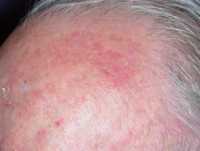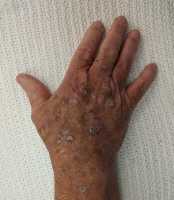MedicalResearch.com Interview with:
Peter C. Friedman, M.D., Ph.D.
Diplomate of the American Academy of Dermatology
www.skincenterderm.com
MedicalResearch.com: What is the background for this study and case series? Would you describe nonthermal atmospheric pressure plasma?
Response: Plasma is essentially ionized gas, the fourth state of matter: molecules or atoms move freely in gas state but in a higher energy state atoms shed electrons and both electrons and ions then move freely and independently. If this material has a temperature close to room temperature, we call it non-thermal atmospheric pressure plasma, or cold plasma.
It has been established in countless in vitro and animal experiments that cold plasma has a significant effect on living cells and tissues, for example: selective destruction of cancer cells, helping normal tissue development, inhibiting bacterial, fungal and even viral proliferation. In the handful of clinical trials it could improve wound healing, treat nail fungus. Our group was able to cure precancerous actinic keratosis lesions in a number of patients in a prior study.
Based on some of the basic science data regarding the specific molecular and intracellular effects of cold plasma, we theorized that it may be able to cure warts, which are caused by human papilloma virus infection. (more…)
Author Interviews, Cancer Research, NEJM / 13.03.2019
Actinic Keratosis: What is the Best Treatment for Pre-Skin Cancers?
MedicalResearch.com Interview with:
Maud Jansen, MD | Resident Dermatology | PhD candidate
Dermatologie, Maastricht
MedicalResearch.com: What is the background for this study? What are the main findings?
Response: Actinic keratosis is the most frequent premalignant skin disease in the white population and is caused by exposure to ultraviolet radiation. With a prevalence of 37.5% among whites 50 years of age or older, actinic keratosis is one of the most frequent reasons for patients to visit a dermatologist. If left untreated, actinic keratosis may develop into squamous cell carcinoma.
Current guidelines provide no clear recommendations about which treatment approach is preferred. Currently, the choice of treatment often depends on the preferences of patients and their treating physicians. Evidence from randomized trials with direct comparison between treatments and with long-term follow-up is scarce.
Frequently prescribed and studied field-directed treatment approaches are 5-fluorouracil cream, imiquimod cream, photodynamic therapy (PDT), and ingenol mebutate gel.
We investigated the effectiveness of these four frequently used field-directed treatments (for multiple lesions in a continuous area). Over 600 patients in four different hospitals (Maastricht UMC+, Zuyderland (Heerlen), VieCuri (Venlo and Venray) en Catharina (Eindhoven)participated in the study. Patients were randomly assigned to one of the four treatments.
The main result of our study was that we found that after 12 months of follow-up, 5% fluorouracil cream was the most effective treatment in the treatment of patients with multiple actinic keratosis lesions. Moreover, patient satisfaction and increase in health-related quality of life were highest in the 5-fluorouracil group. (more…)
Author Interviews, Cancer Research, Dermatology / 15.12.2018
Dermatologist Discusses Personalized Approach to Skin Cancer Treatment
MedicalResearch.com Interview with:
Dr. Kristine A. Romine MD
CEO and Founder of Camelback Dermatology & Skin Surgery
Phoenix, AZ
MedicalResearch.com: Would you give a brief overview of the different types of skin cancer?
Response: There are multiple types of skin cancer, including: melanoma, basal cell carcinoma, squamous cell carcinoma, and actinic keratosis. Known as the deadliest form of skin cancer, melanoma develops when irreparable DNA damage results in malignant transformation of melanocytes. This type of skin cancer is most commonly caused by intense UV exposure from the sun or tanning beds, which activate mutations that lead skin cells to rapidly multiply and form malignant tumors. Melanoma can range in color from dark brown to black and are rarely red or even skin colored. They are usually irregular and asymmetrical. In 2018, there were an estimated 91,270 new cases of melanoma (American Cancer Society, 2018).
Basal cell carcinoma (BCC) is the most common type of skin cancer and cancer diagnosed. BCCs arise in the skins’ outermost layers. BCCs resemble open sores, red or pink plaques, pearly nodules with telangiectasia, or scars. It is estimated that 4.3 million BCCs are diagnosed in the U.S. every year (Skin Cancer Foundation, 2018).
Squamous cell carcinoma (SCC), the second most common type of skin cancer, arises from the squamous cells in the skin that have been exposed to UV over long periods of time. SCCs appear as scaly red or pink macules, papules, or plaques. They can be crusted and appear eroded and can commonly arise within a solar keratosis. More than 1 million cases of SCC are diagnosed in the U.S. every year (Skin Cancer Foundation, 2018).
Lastly, actinic keratoses (AKs) are the most common pre-cancerous skin growth that can develop into a SCC if left untreated. Similar to all other types, AKs are caused by exposure to UV light and, in rare cases, high exposures to x-rays. AKs can appear on sun-exposed areas, including the face, scalp, ears, shoulders, and legs. They resemble pink, scaly rough patches on the skin.
(more…)
Author Interviews, Cancer Research, Cost of Health Care, Dermatology, Emory, JAMA, Medicare / 21.09.2018
Medicare Spends Hundreds of Millions Annually to Treat Precancerous Skin Lesions
MedicalResearch.com Interview with:
 Howa Yeung, MD
Assistant Professor of Dermatology
Emory University School of Medicine
Atlanta, GA 30322
MedicalResearch.com: What is the background for this study? Would you briefly explain what is meant by actinic keratoses?
Response: Actinic keratoses are common precancerous skin lesions caused by sun exposure. Because actinic keratoses may develop into skin cancers such as squamous cell carcinoma and basal cell carcinoma, they are often treated by various destructive methods. We used Medicare Part B billing claims to estimate the number and cost of treated actinic keratoses from 2007 to 2015.
MedicalResearch.com: What are the main findings?
Response: While the number of Medicare Part B beneficiaries increased only moderately, the number of actinic keratoses treated by destruction rose from 29.7 million in 2007 to 35.6 million in 2015. Medicare paid an average annual amount of $413.1 million for actinic keratosis destruction from 2007 to 2015. Independently billing non-physician clinicians, including advanced practice registered nurses and physician assistants, are treating an increasing proportion of actinic keratosis, peaking at 13.5% in 2015.
MedicalResearch.com: What should readers take away from your report?
Response: Readers should understand that the burden of actinic keratosis treatment is increasing in the Medicare population. There is also an increasing proportion of actinic keratoses being treated by advanced practice registered nurses and physician assistants. (more…)
Howa Yeung, MD
Assistant Professor of Dermatology
Emory University School of Medicine
Atlanta, GA 30322
MedicalResearch.com: What is the background for this study? Would you briefly explain what is meant by actinic keratoses?
Response: Actinic keratoses are common precancerous skin lesions caused by sun exposure. Because actinic keratoses may develop into skin cancers such as squamous cell carcinoma and basal cell carcinoma, they are often treated by various destructive methods. We used Medicare Part B billing claims to estimate the number and cost of treated actinic keratoses from 2007 to 2015.
MedicalResearch.com: What are the main findings?
Response: While the number of Medicare Part B beneficiaries increased only moderately, the number of actinic keratoses treated by destruction rose from 29.7 million in 2007 to 35.6 million in 2015. Medicare paid an average annual amount of $413.1 million for actinic keratosis destruction from 2007 to 2015. Independently billing non-physician clinicians, including advanced practice registered nurses and physician assistants, are treating an increasing proportion of actinic keratosis, peaking at 13.5% in 2015.
MedicalResearch.com: What should readers take away from your report?
Response: Readers should understand that the burden of actinic keratosis treatment is increasing in the Medicare population. There is also an increasing proportion of actinic keratoses being treated by advanced practice registered nurses and physician assistants. (more…)
 Howa Yeung, MD
Assistant Professor of Dermatology
Emory University School of Medicine
Atlanta, GA 30322
MedicalResearch.com: What is the background for this study? Would you briefly explain what is meant by actinic keratoses?
Response: Actinic keratoses are common precancerous skin lesions caused by sun exposure. Because actinic keratoses may develop into skin cancers such as squamous cell carcinoma and basal cell carcinoma, they are often treated by various destructive methods. We used Medicare Part B billing claims to estimate the number and cost of treated actinic keratoses from 2007 to 2015.
MedicalResearch.com: What are the main findings?
Response: While the number of Medicare Part B beneficiaries increased only moderately, the number of actinic keratoses treated by destruction rose from 29.7 million in 2007 to 35.6 million in 2015. Medicare paid an average annual amount of $413.1 million for actinic keratosis destruction from 2007 to 2015. Independently billing non-physician clinicians, including advanced practice registered nurses and physician assistants, are treating an increasing proportion of actinic keratosis, peaking at 13.5% in 2015.
MedicalResearch.com: What should readers take away from your report?
Response: Readers should understand that the burden of actinic keratosis treatment is increasing in the Medicare population. There is also an increasing proportion of actinic keratoses being treated by advanced practice registered nurses and physician assistants. (more…)
Howa Yeung, MD
Assistant Professor of Dermatology
Emory University School of Medicine
Atlanta, GA 30322
MedicalResearch.com: What is the background for this study? Would you briefly explain what is meant by actinic keratoses?
Response: Actinic keratoses are common precancerous skin lesions caused by sun exposure. Because actinic keratoses may develop into skin cancers such as squamous cell carcinoma and basal cell carcinoma, they are often treated by various destructive methods. We used Medicare Part B billing claims to estimate the number and cost of treated actinic keratoses from 2007 to 2015.
MedicalResearch.com: What are the main findings?
Response: While the number of Medicare Part B beneficiaries increased only moderately, the number of actinic keratoses treated by destruction rose from 29.7 million in 2007 to 35.6 million in 2015. Medicare paid an average annual amount of $413.1 million for actinic keratosis destruction from 2007 to 2015. Independently billing non-physician clinicians, including advanced practice registered nurses and physician assistants, are treating an increasing proportion of actinic keratosis, peaking at 13.5% in 2015.
MedicalResearch.com: What should readers take away from your report?
Response: Readers should understand that the burden of actinic keratosis treatment is increasing in the Medicare population. There is also an increasing proportion of actinic keratoses being treated by advanced practice registered nurses and physician assistants. (more…)



